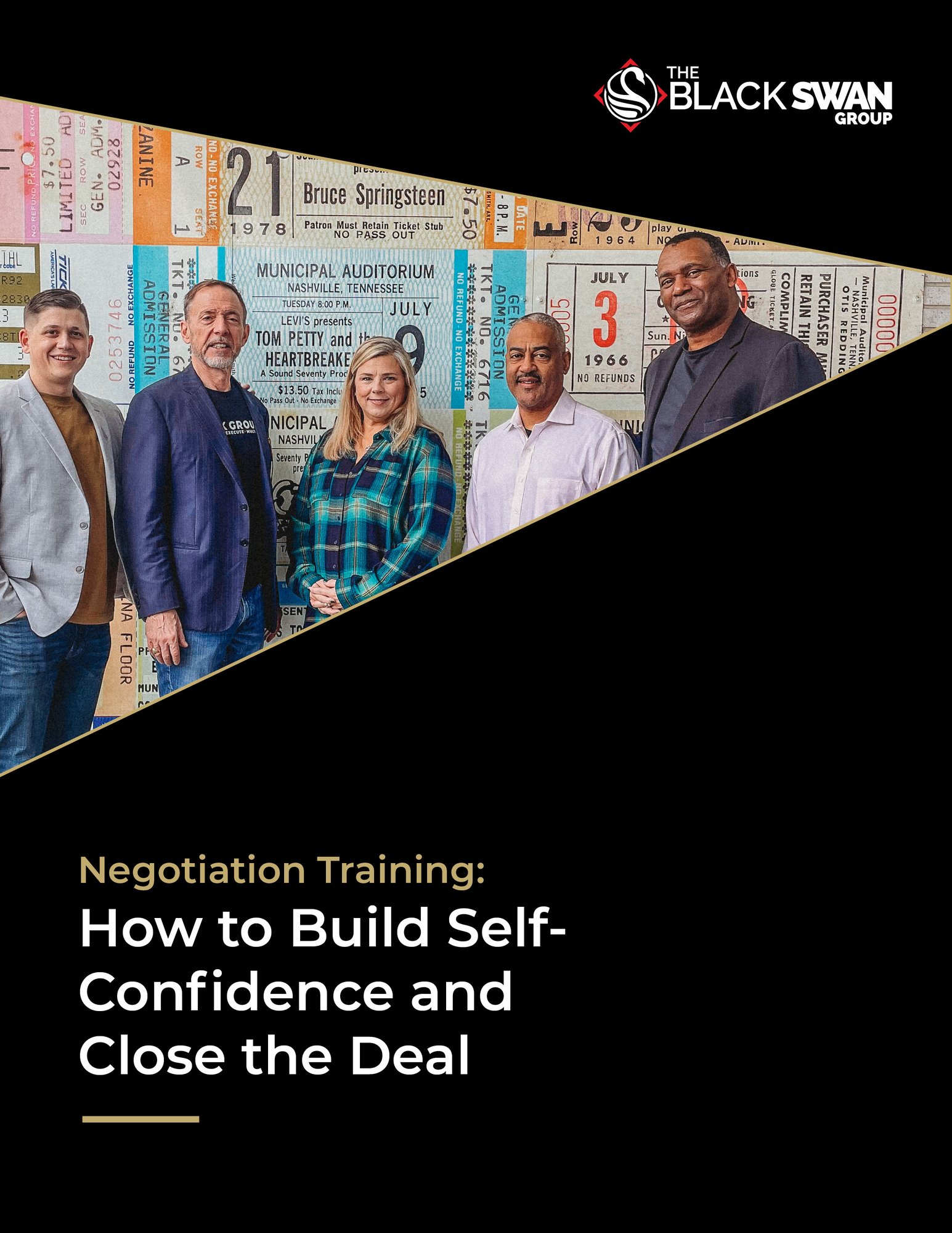Introduction
In an ideal world, every time you sat down at the table to make a deal, you would be greeted by a friendly, cordial counterpart who’s guided by logic and never lets emotion get the best of them.
Wouldn’t that be nice?
Of course, it rarely (if ever) works out that way. In the world of high-stakes negotiations, it’s only a matter of time before you’re staring across the table at someone who is extremely difficult to deal with. That’s just the way it is.
Rather than try to sidestep a difficult conversation or automatically cater to your counterpart’s whimsies to get out of one, use these five tried-and-true tactics to effectively deal with difficult people during negotiations.
Download a PDF version of the guide by filling out this form, or keep scrolling to read.

Chapter 1
Chapter 2
Chapter 3
Chapter 4
Chapter 5
Chapter 6

1. Prepare for the worst, and accept how hard the conversation is going to be.
Being successful in difficult negotiations starts with having the right mindset when you sit down at the table. Unfortunately, far too many negotiators walk into the room believing the conversation will go smoothly. They start thinking of reasons why the counterpart will like them and reasons why they won’t be angry.
This mindset will get you into trouble very, very quickly. For starters, you’re setting yourself up to ignore how your counterpart thinks about things and their justifications for having those thoughts—essentially making it impossible to use Tactical Empathy™.
On top of that, although you might not mean it intentionally, there’s a lot of arrogance in thinking things will go well and that, if a problem arises—let’s say you were a day late on a deliverable in a contract—you’ll be able to talk them out of it. You had a great reason, right? And your counterpart, being as rational as they are, will no doubt understand that logic and be cool with it.
Just take a step back and think about how arrogant that sounds. You don’t know what’s on their mind or driving their thinking because you can’t read their inner monologue.
When you believe you can talk the other side through an issue and ignore how they actually feel about it, it sets you up to be betrayed by your inner voice. When you think it’ll be easy to get on the same level, it’s very hard to come across as genuinely understanding of your counterpart’s perspective because your inner voice betrays your outer voice.
It’s all about mindset.
Effectively navigating difficult negotiations starts with avoiding the wrong mindset—and the negative ripple effects that mindset brings along with it.
So instead of thinking that your job will be easy and the conversation will flow smoothly and logically, you need to accept that the conversation is going to go sideways, and there is nothing you can do about it. No matter what, it’s going to be contentious, and the other side is going to have weird reasons for being mad.
Once you accept this fact, it becomes much easier to read between the lines and listen at a different level—using the active listening required to achieve Tactical Empathy.
Keep in mind that you can’t simply decide to “listen at a different level” and make that happen. When you decide to listen closer, you often end up listening just enough to formulate your rebuttal.
Becoming a better listener starts with being genuinely curious and accepting that your counterpart has legitimate reasons to feel the way they do. You have to understand that—based on the way they see things—their perspective is entirely legitimate. Once you accept that legitimacy, you can begin to verbalize their argument, setting off a chain reaction that ultimately leads to the two magic words: “That’s right”™.
When you believe you can talk the other side through an issue and ignore how they actually feel about it, it sets you up to be betrayed by your inner voice.

2. Know how to prepare.
Preparation is important—even when it comes to breathing.
Depending on the activity you’re engaged in, the way you breathe will be closely tied to your performance. When you’re meditating, you might take long, deep breaths. When you’re scuba diving, you’re going to struggle underwater if you breathe the same way. And if you’re boxing, you want to make sure to exhale when you throw a punch so it lands with maximum impact.
We all know preparation is important for negotiation. But knowing how to prepare is much more important than preparing in general—just like knowing how to breathe for the activity you are engaged in is more important than breathing in general. At the end of the day negotiation is a “human performance event”
Doing a bunch of research on somebody’s background isn’t necessarily great preparation. You’re not going to find out everything through Google searches and phone calls. Instead, you’re going to learn more if you hear it directly from the horse’s mouth.
Your goal should be to get the other side to lay everything out on the table for you. To do this, you need to figure out how to structure your communication in such a way that the other side feels comfortable sharing things they wouldn’t tell anyone else—the Black Swans that are hidden beneath the surface of the conversation.
Find the Black Swans.
When you’re in a difficult negotiation, at least three to five Black Swans exist somewhere between you and your counterpart. After all, this is the reason the experience is difficult in the first place. For whatever reason, you haven’t been able to uncover and address the Black Swans to this point, and that’s what’s gotten you into this complex situation.
As you begin preparing for a difficult negotiation, you need to figure out how to get the other side to open up and explain the way they see things. You also need to uncover and state the Black Swan that led you to this juncture.
For the best results, spend most of your prep working on your Accusation Audit (AA)™ so you can preemptively identify and defuse the negative sentiments likely harbored by the other side. By focusing on the AA, you will guide your thinking in the right direction moving forward.
Although no-oriented questions, Calibrated Questions™, and Labels™ can also be helpful, if there’s one thing you focus on, let it be the AA (your questions and Labels should relate to it, anyway).
Ideally, you’ll already have a go-to list of 5-10 Labels to rely on in every negotiation, speeding up your prep even more.
Doing a bunch of research on somebody’s background isn’t necessarily great preparation. You’re not going to find out everything through Google searches and phone calls. Instead, you’re going to learn more if you hear it directly from the horse’s mouth.

3. Ask Proof of Life™ questions.
Take a step back. Do you know whether you’re the favorite or the fool?
Although it might not seem like it, Proof of Life™ questions may actually be a great tool to utilize in a difficult negotiation. That’s because you’re almost certainly in a difficult spot for one of two reasons: One, there are problems occurring that the other side wants to fix before making a deal, or two, your counterpart is looking to sever the relationship altogether.
It’s not a sin to not make a deal. But it is a sin to not make a deal and waste a ton of time doing so. This is where Proof of Life can be particularly helpful in determining if the other side wants to get past an issue, or if they’re keen on never talking to you again.
In fact, you can even sprinkle in your Proof of Life question into your Accusations Audit: There are a lot of options in the industry. There are other places you could go to attack this problem. Based on where we are, you’re obviously not happy with how we’ve progressed. There are things you wish we could have done better. We know that there are decisions that need to be made on your side, which is why we come together today. Why us?
This approach will get you answers faster. If the other side responds like this—It’s interesting you mentioned that; we want to sever the relationship today—you can respond quickly with a Label—It sounds like you have specific pain points you want to address.
Being direct is a great way to get down to brass tacks, open up the conversation, and attempt to work your way through problems. At the same time, if you’re thinking about dropping the client, they’ve just shortcut the process for you, and you can separate with no bad blood.
On the flip side, if the other side responds to your Proof of Life question in the affirmative—You’ve shown us great things, you have a great reputation, and we think your products and services are best-in-class—you’re still in a fantastic spot.
It’s not a sin to not make a deal. But it is a sin to not make a deal and waste a ton of time doing so.

4. Lean on no-oriented questions.
If you’re in a contentious interaction and your goal is to get the other side to agree to do business with you, the yes path will not get you there.
That’s because the word yes is fickle. There are three different types of yeses, and people often use the word yes to get out of difficult situations. On top of that, your counterpart is already primed to say no. If they’re angry, and you’ve reached a difficult point in the negotiation, no is already on the tip of their tongue.
If that’s where your counterpart’s mindset is, you might as well use no to your advantage. After all, we all have a natural sensitivity to the word yes, and that sensitivity is compounded when you’re walking into a difficult negotiation—especially if the other side initiated the difficulty.
Think about it: When you’re in a difficult negotiation, your counterpart is thinking about not giving you the agreement you’re searching for. In such a scenario, fishing for the biggest word for agreement in the history of human civilization—yes—is probably something you want to stay away from.
Fish for no instead: Are you against moving forward? Is it impossible to fix our current status? Sooner or later, you’ll find out why the best negotiators always aim for no.
We all have a natural sensitivity to the word yes, and that sensitivity is compounded when you’re walking into a difficult negotiation—especially if the other side initiated the difficulty.

5. Don’t forget about the “I” message!
When you’ve exhausted your Accusations Audit, Proof of Life, and no-oriented questions and are still at an impasse, it’s time to pull the “I” message out of your sleeve.
“I” messages aren’t foreign to the negotiation world or the private sector, but we teach them a bit differently at Black Swan. Simply put, “I” messages are designed to confront undesired behaviors. If you’re getting a reaction from them that is poor—think anger, frustration, or narcissism—“I” messages are a good fit.
“I” messages are made up of three parts:
- When you [do the unwanted behavior (e.g., yell)]
- I feel [the way you feel (e.g., I’m letting you down)]
- Because [reason the behavior is a problem (e.g., we need to make sure to take good care of you throughout this contract)]
Here, you might want to lean into self-deprecation. Why? Because when you can self-deprecate, you immediately disarm yourself and are no longer a threat.
One of the reasons difficult negotiations are so hard is because both sides feel threatened by the other. If you can make your counterpart feel safer because you are no longer a threat, that is going to be great for you.
Word to the wise: Think of an “I” message as a “break glass in case of emergency” skill. And whatever you do, don’t use “I” messages more than twice during any negotiation. If you lean on them too much, the other side will feel like you’re a brick wall that nothing gets past, derailing your efforts.
If you’re getting a reaction from them that is poor—think anger, frustration, or narcissism—“I” messages are a good fit.

Learn more about the person across the table.
In addition to these tools, it’s also important to learn as much as you can about the person sitting across the table to determine what negotiator type they are. The easiest way to do this is by leading with your Accusations Audit.
After you state your AA, an Accommodator will likely jump in and correct you immediately after you say something they disagree with because they are so relationship-focused.
An Assertive will likely think to themselves that you’ve hit all the main points, so it’s time to move on.
Analysts are the hardest to read. Chances are, there will be a lull in the conversation after you’ve finished your AA because the Analyst will need time to process what you’ve said. So give them that time: Count to 10-Mississippi before you say anything else.
Because you’re reading these words, you’re no doubt interested in sharpening your negotiation skills so you can achieve better outcomes next time you’re in a difficult place. Although the takeaways from this e-book will help you start thinking in the right direction, consider this a primer.
Download a PDF version of the guide by filling out this form:


